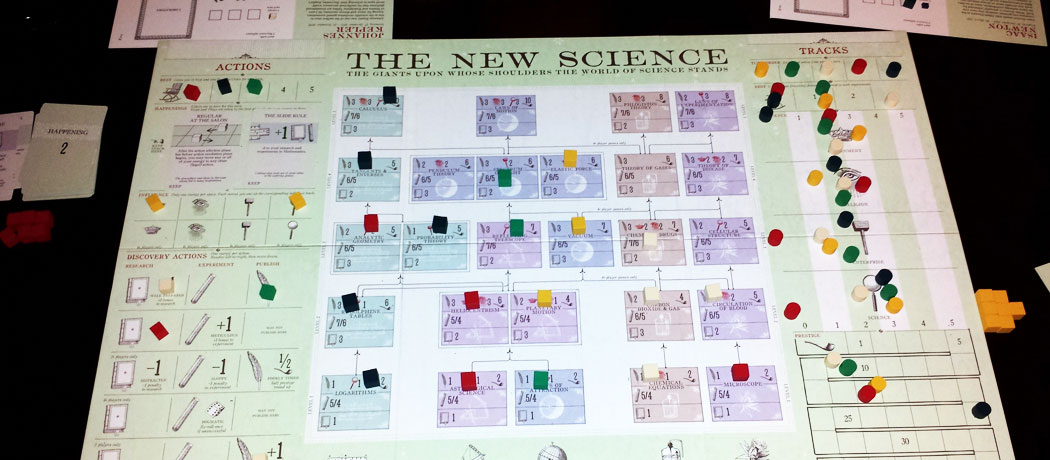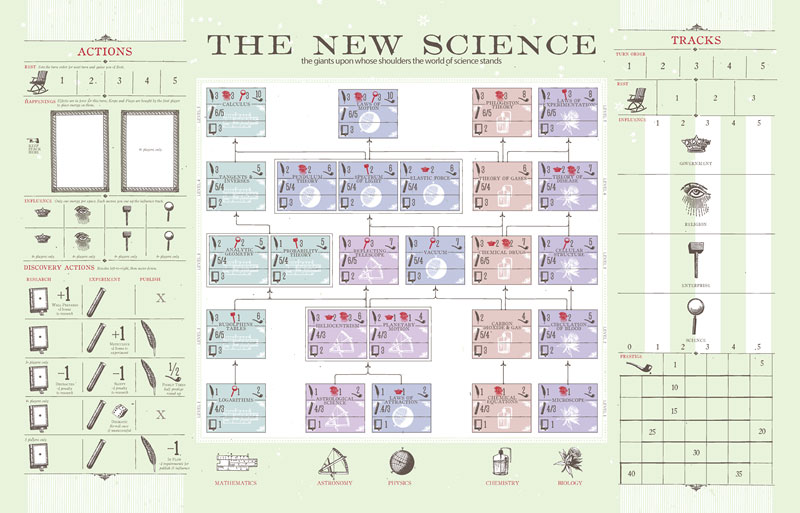Advertisement
Game About Discoveries, Intrigues Of 17th Century ‘New Science’ Isn’t Child’s Play

Remember when “Rock Band” became popular enough that people wondered whether all that time playing it might be better spent learning a real musical instrument?
I mused analagously about “The New Science,” a board game published by Conquistador Games after a successful 2013 Kickstarter campaign. In it, each participant plays one of the great figures of 17th century discovery—Kepler, Leibniz, Galileo, Newton, or Kircher—and competes against each other for scientific glory. Getting started playing was such a challenge that I wondered if the effort might be better spent on a real-world scientific problem. But once I scaled the precipitous learning curve, it grew clear that there was fun to be had.
“The New Science” is a worker placement game. For the uninitiated, worker placement is a category of game mechanics in which players allot limited resources into opportunities on the board. Each placement allows the possibility of building more resources. The roll of the die decides the rewards, but typically in a WPG your mere occupation of an opportunity blocks other players from any reward at all there.
If you have never played a WPG, do not start with “The New Science.” “Alien Frontiers” by Clever Mojo Games would be a better choice, or “Lords of Waterdeep” by Wizards of the Coast if you prefer the “Dungeons & Dragons” universe.
In fact, my first attempts to play “The New Science” were so bewildering that I finally lent it to a more seasoned gamer in our merry circle of adventurers and asked him to figure it out. The game that he led for us, with five players including himself, made sense and was quite fun. Upon reflection, the rules weren't so badly explained, but with an inadequate frame of reference as to how WPGs are played in general, they were nigh incomprehensible. With my friend leading the way, though, things snapped into place.

Each player has three energy markers. (In terms of game mechanics, these are the workers to be placed.) Players take turns putting them on the left side of the board, where all the allocation options are. The possibilities are numerous, and each of them is needed at some point in the game. The first allocation category is Rest. By using rest, buring the midnight oil as it were, players can make up for deficient die rolls. Should some accomplishment require a 5, and you roll a 4, you can use a point of rest to cover the difference. Also, who first takes rest determines the order of play on the next turn. Consequently rest is one of the most powerful options on the board.
The next category is the Happenings, represented by a deck of cards turned over two at a time. Players can claim one with an energy marker and affect gameplay later in various ways. For instance, a card representing the acquaintance of Pierre de Fermat causes everyone angling for more influence (see below) to get a bonus for research and experimentation (also see below). (I told you this was complicated.) (In real life, Fermat was a 17th-century lawyer and amateur mathematician who left for us, among much else, a mathematical theorem doodled in a book margin that wasn't proven until 1995.)
The next category is Influence. Markers placed here increase one's traction in the spheres of government, religion, enterprise, or science. The last category is Discovery. Here is a grid for which each square is an opportunity to research, experiment, or publish.
Once energy markers are allocated, the next phase of play begins, that of Action Resolution. Reading the markers on the left side of the board like a book, left-to-right and top-to-bottom, players determine turn order, tally rest for each player, take any claimed Happening cards, and tally influence in each sphere. Tallies are kept with a cylindrical marker color-coded for each player, placed on tracks on the right side of the board. Then the meaty part of the game takes place: the action of research, experiments, and publication.
The areas of research are described by the wide center portion of the board. Encompassing mathematics, astronomy, physics, chemistry, and biology, they form a ladder of discovery in which simpler accomplishments like the physics of planetary motion lead to, for instance, understanding of the vacuum. Each area has a research requirement, an experimentation hurdle surmounted by the successful roll of the die, and a publishing requirement that entails sufficient influence.
Publishing is a serious strategic concern. It gains you prestige (also tracked with a cylinder), and the player with the most prestige at the end of the game wins. On the other hand, publishing allows competing scientists to begin work in more advanced fields, building on your discoveries, and the more advanced fields promise greater quantities of prestige. When they have discovered all they can and published what they will, the energy markers are returned and the next turn begins. The game ends when the highest levels of discovery are published, or when the Happening cards run out.
As is typical of a game this complicated, early play with imperfect familiarity with the rules feels a bit like filling out a college application, but by the third turn it picks up noticeably. Each scientist has his own advantages. Newton, for instance, gets +3 on experimentation rolls and +1 on research. Becoming familiar with your character can give you an edge if you can figure out how to employ his strengths. Scientists at similar points of discovery in the same area of research can race each other to publish, not only to win prestige for themselves but to deprive it of their colleagues. While the game can accommodate two players, it's easier to understand and markedly more competitive with the full maximum of five.
Graphically the game is beautifully designed with historical engravings and good choices in color and typography. I have one production quibble—the energy markers and the discovery markers, the former for allocation and the latter for tracking work in the research areas, are both cubes, and they're an eighth of an inch different in size. It happened several times that someone allocated a discovery marker as if it were energy, an easy mistake to make and a nearly invisible one as well. You realize it soon enough because you or your fellow researchers figure out that you have four units of energy to everyone else's three, but it's a nuisance to have to keep your eye out like that when there's already plenty of legitimate gameplay to wrap your head around. It would have been an act of kindness for those not well-versed in WPGs to have more illustrations in the rule book.
Despite the steep learning curve this is a satisfying and well-designed game. It's also refreshing to reside imaginatively in this particular milieu, playing Gallileo and battling Newton with research instead of playing a robot and battling a giant lizard with lightning bolts, not that I'm not raring to go back and play King of Tokyo. The possibility of absurdities like Leibniz discovering phlogiston theory turned out not to be distracting—“The New Science” gives you a sense of what ideas were in play at the time, and a feeling for the enormous demands placed upon the principal thinkers of the age.
Franklin Einspruch is a Boston-based artist and writer. "The Fire to Say: Comics as Poetry," an exhibition he organized at the Winkleman Curatorial Research Lab in New York, runs through Feb. 15.